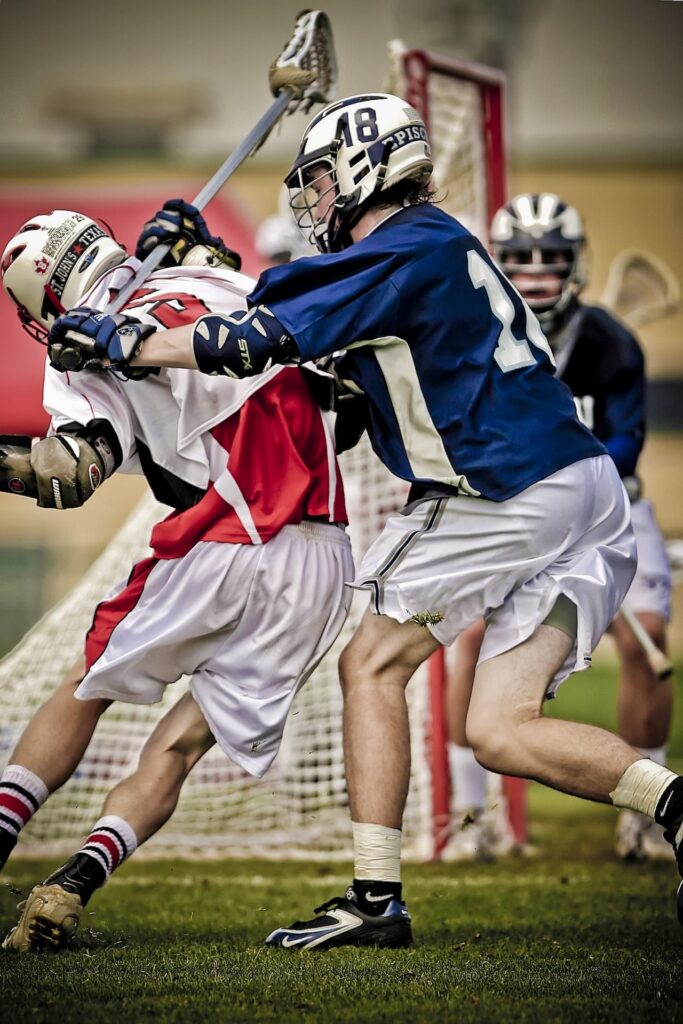Lacrosse is one of the fastest growing sports in America. But where did lacrosse come from? When was the game invented and how did it evolve into the athletic competition we know today? This article will explore the origins and history of lacrosse.
Early Native American Roots
Lacrosse has its origins in stickball games played by various Native American tribes long before European settlers arrived. These indigenous peoples played games using sticks with nets to catch and throw balls or objects.
Lacrosse-like games were documented as early as the 17th century among the Iroquois Confederacy of nations located in what is now New York state and southern Canada. The Mohawk tribe in particular was known for an early form of lacrosse.
Native American stickball games were played for recreation, spiritual rituals, war preparation, and to resolve conflicts. Teams could consist of hundreds of players covering miles of terrain. Goals were often trees or other landmarks over half a mile apart.
The violent contests served as substitutes for war and could result in severe injury or death. But the games also built strength and camaraderie and were preceded by days of spiritual ceremonies and preparation.
While Native American tribes played versions of lacrosse for centuries, the Iroquois in particular emerged as masters of the game in the eastern woodlands by the 1800s. Their style of play heavily influenced the standardized sport of lacrosse as it developed later on.
What Was Lacrosse Originally Called?
Lacrosse was not always known by its current name. The indigenous tribes who played early versions of lacrosse-style games over the centuries had their own names for the game in their native languages.
The Huron tribe referred to their lacrosse-type game as “tekasekresh” which translated to “little brother of war.” Other tribes had names like “baggataway”, “tachquaraqunday”, or “stickball“.
Eventually, as French settlers observed Native American tribes playing the game that would evolve into modern lacrosse, they coined their own descriptor – “la crosse.” This was likely due to the stick looking similar to a Bishop’s crozier or staff.
The name “lacrosse” was standardized when Canadian dentist William George Beers helped codify the modern rules and popularize the game in the 1800s. He championed the name lacrosse to give the burgeoning sport a proper identity.
So while lacrosse traces its origins to Native American stickball games, the specific name lacrosse was created by European settlers based on the curved sticks that looked like Crosiers or Bishops’ staffs. The indigenous tribes had their own unique names for their ancient games that formed the foundation of the structured sport today.
1800s: Standardization and Growth
In the first half of the 19th century, as lacrosse-style games rose in popularity, non-Native American players began adopting and playing their own versions throughout Canada and upstate New York.
Canada’s Montreal Lacrosse Club formed in 1844 and standardized a universal set of rules based on the Iroquois game. This led to the emergence of organized competitive lacrosse teams and leagues in North America centered in Montreal, New York, and Toronto.
Queen Victoria observed an exhibition lacrosse game in 1849 during a visit to Canada and remarked that it was “very pretty to watch.” Her endorsement helped fuel lacrosse’s growth as a popular sport in Victorian England.
Throughout the second half of the 19th century, lacrosse matches became well-attended spectator events and amateur leagues were established in the United States, Canada, England, Scotland, Ireland, and Australia.
The game continued evolving as governing bodies formed to merge different rule sets and organize competitions and championships. Equipment improved from informal sticks to manufactured crosses with mesh netting.
By the early 1900s, the foundations were firmly in place for lacrosse to grow into a modern competitive sport.
1900s Onward: College, Olympics, and Pro Leagues
In the 20th century, lacrosse in North America shifted from community-based amateur leagues to being anchored by college programs. The first collegiate lacrosse association formed in 1882.
The NCAA began sanctioning men’s lacrosse championships in 1971, spurring tremendous growth at the intercollegiate level throughout the latter decades of the century. Women’s lacrosse followed suit, spreading rapidly throughout colleges in the 1970s and 1980s after standardized rules were established.
This growth at the university level gave lacrosse more structure, visibility, and legitimacy. Amateur club and high school lacrosse leagues also greatly expanded participation opportunities.
At the international level, lacrosse has been a contested sport in the Summer Olympics since 1904 (aside from 1932 and 1948). Canada, the Iroquois Nationals, and the United States have won most Olympic medals.
In the professional ranks, the National Lacrosse League (NLL) formed in 1986 as the first pro indoor league. Major League Lacrosse (MLL) followed in 2001 as the initial professional outdoor lacrosse circuit.
In 2019, Paul Rabil and his brother launched the Premier Lacrosse League (PLL) as an improved pro model showcasing the best players in the world. This further accelerated the burgeoning popularity of pro outdoor lacrosse.
The Creation of Modern Lacrosse
While Native Americans unquestionably invented the roots of lacrosse, the standardized sport we know today emerged through the convergence of several key developments:
- Native American stickball rituals, games, and warfare
- 1800s adoption by non-Native American Canadians/Americans
- Victorian Era growth and codification of rules
- Rise of collegiate and Olympic competitions
- Formation of professional leagues
So the origins of lacrosse stretch back centuries. But the structured, organized sport crystallized over a long evolution beginning in the 1800s. Through this transformation, a uniquely North American indigenous game became a modern international sport.
Lacrosse Continues to Grow
From its Native American origins to the 21st century, lacrosse has come a long way and continues to expand. Key milestones in the history and growth of lacrosse include:
- 17th century: Lacrosse-like games documented among Iroquois tribes
- 1844: Standard rules adopted by Montreal Lacrosse Club
- 1849: Queen Victoria watches exhibition game in Canada
- Late 1800s: Leagues and championships form in US and Canada
- 1900-50s: Collegiate lacrosse associations and programs founded
- 1904: Lacrosse debuts as Olympic medal sport
- 1970s-80s: NCAA and women’s lacrosse growth at college level
- 1986: National Lacrosse League forms as first pro indoor league
- 2001: Major League Lacrosse launches as first pro field league
- 2019: Premier Lacrosse League debuts as new pro model
Today, lacrosse is contested by over 1 million players globally. The ancient game continues to reach new heights in the 21st century as one of the fastest growing team sports. Understanding the rich history and origins of lacrosse sheds light on why this iconic activity holds a unique place in North American sporting culture. From its Native American roots to the upper echelons of amateur and pro play today, lacrosse has come a long way while still maintaining its distinctive heritage.


